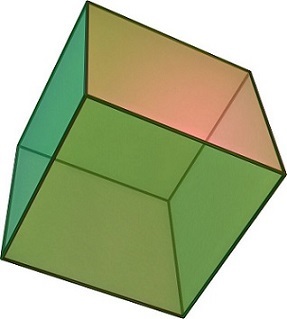Strange Polyhedron
 A cube has 8 vertices, 12 edges, and 6 faces.
A cube has 8 vertices, 12 edges, and 6 faces.
Is there a convex polyhedron that has 9 vertices, 13 edges, and 6 faces?
This section requires Javascript.
You are seeing this because something didn't load right. We suggest you, (a) try
refreshing the page, (b) enabling javascript if it is disabled on your browser and,
finally, (c)
loading the
non-javascript version of this page
. We're sorry about the hassle.
1 solution
Nothing was said about the polyhedron being regular, just convex.
Euler's Polyhedral Formula is V + F - E = 2.
This convex polyhedron passes. Therefore the answer is yes.
Log in to reply
The condition I gave on vertices and edges has nothing to do with the polyhedron being regular. Not every triple V , F , E that satisfies V + F − E = 2 has a corresponding polyhedron (just take, say, V = 3 to see this). Alternatively, Wikipedia gives a full list of possible hexahedra here .
Log in to reply
Your argument does not work. It fails on a two-faced triangle. 3 vertices, 3 edges and 2 faces.
Log in to reply
@A Former Brilliant Member – Well, is that a convex polyhedron? It's certainly debatable. Anyway, you're suggesting any such triple is valid. So take V = 3 , F = 1 , E = 2 . I don't see how two edges can join three vertices that surround a face. A convex polyhedron certainly has an Euler characteristic of 2 , but this isn't a sufficient condition.
You could also look at different extremes, for instance V = 4 , F = 9 9 9 , E = 1 0 0 1 .
Again, the article I linked to above has a full listing of topologically distinct hexahedra (convex and concave); an alternative source with a bit more info is here , and MathWorld has a similar article here .
A slightly fuller version of the 2 E ≥ 3 V argument is here .
Log in to reply
@Chris Lewis – I note that polyhedra are not consistently defined. One of the definitions that I have encountered would have included the admittedly degenerate case of the two-faced triangle. It would be included even in the convex polyhedron case as all line segments would remain within it. I have seen a version of Euler's proof of the Euler characteristic formula which stopped at that case as its base case.
Perhaps the problem statement might have said convex polyhedra of non-zero volume because that would eliminate all the degenerate cases of which I am aware.
In any case, I deleted my report.
Log in to reply
@A Former Brilliant Member – I wonder if there's a simple degenerate case that works for this problem? It's a bit of a Pandora's box of possibilities in terms of what might be "allowed". I can see how to do it by doubling up four edges on a triangular bipyramid, but that definitely feels like cheating.
Of the seven known convex hexahedron, only the cube and one other has many as 12 edges. There are none with 13 edges, and none with 9 vertices.
Every vertex belongs to at least three edges. Each edge joins exactly two vertices. Hence 2 E ≥ 3 V for any polyhedron. So there can be no polyhedron with 1 3 edges and 9 vertices.